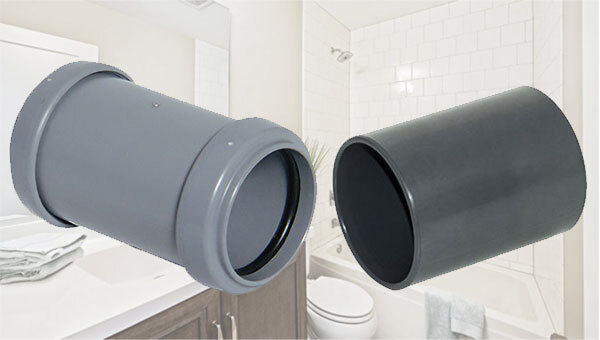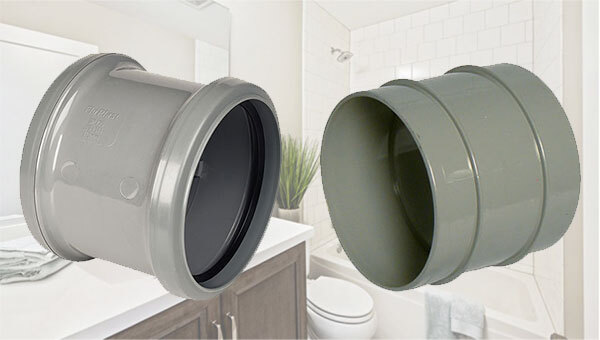
Most guttering bought from any reputable manufacturer will come with at least a 10 year guarantee. However, with the proper maintenance routine, the serviceable lifespan of your system can be extended well beyond this.
Whether it is simply giving them a good clean once a year, or fixing a leak that’s causing a waterfall of water outside your front door, chances are that you’ll inevitably have to think about the health of your gutters at some point. But what exactly do you need to know? How much maintenance do they require? What’s the worst that can happen if you neglect your guttering? These are just some of the questions that we will attempt to answer for you in this article.
Why you need to clean your gutters
Rainwater guttering plays an integral part in the wellbeing of your house. It provides a simple, yet highly effective, means by which the rain running off your roof is collected and carried away from your home to protect it from water damage.
It's a simple system, yes, but don't let that fool you. A single fault or blockage in any part of it can result in the collected rain water causing damage to your roofing and fascia, or running down your walls and soaking into the foundations of your home. All it then takes is for there to be a crack in the wall, or an exposed cavity round a window or door, and that water can penetrate into the internal walls where it can then cause damp and mould too.
One of the most common causes of gutter related problems comes from allowing leaves, moss and other debris to build up and form blockages. The weight of the damp debris can also cause the gutters to sag, which prevents the water from being channelled away as effectively, resulting in pools of water forming which creates even more weight. Eventually, this can lead to joints failing and causing leaks, or even to your gutters collapsing altogether.
All of this can be avoided though, by simply cleaning out your gutters on a regular basis.
How often should you clean your gutters
The short answer to this question is that, according to industry experts, you should ideally try to clean your gutters at least twice a year; once towards the end of Spring and then again in the Autumn.
The reason for these recommendations is due to those times of year typically being the worst for leaf litter and debris falling into your gutters. Throughout the Spring, trees and flowers release seeds and pollen into the air and birds fly over your roof with easily droppable nesting material. All of these things can fall into your gutters and downpipes and help the formation of blockages. Towards the end of Spring, the occurrence of this natural litter starts to decline, making it a good time to clean your gutters without having to worry about it all just building up again a few weeks later.
Autumn is another time of the year when the natural world likes to drop its litter everywhere, this time in the form of blankets of leaves that fall from the trees. Autumn leaves falling into your gutters is a recipe for a soggy mush that can really gum up the works. Giving your gutters a good clear out when the trees around your property are nearly bare lets you tackle as much of the potential clogging material in one go before the winter weather starts to set in. This one is especially important for that reason, so much so that it's even one of our top ten tips to winter-proof your home article.
The problem with this twice a year recommendation, however, is that it makes the general assumption that every property will experience the same level gutter blocking debris falling on their roofs, which is unlikely at best. If you live in a built up city, you may be less likely to be plagued by leaf litter then if you lived out in the countryside, for example. If you tend to get a lot of moss build up on your roof, which is prime blockage material just waiting to be dislodged by the wind and rain, or you live surrounded by trees, you may need to think about cleaning your gutters 3 or 4 times a year to keep them clear.
Knowing when and how often to clean your gutters will ultimately come down to your own experience with your property, and just being aware of any extreme weather events that could cause more debris to be dumped on your roof than normal. It's always worth taking a look at your gutters after a bad storm, even if it happens only a week after you last cleaned them out. We recommend twice a year as a minimum, but use your own judgment to decide if your guttering requires more frequent care.
Top Tip: If a bad storm is predicted, it's worth cleaning out your gutters before it hits. Preemptive gutter maintenance is far more pleasant on a dry day than emergency gutter maintenance is on a damp day after a storm that left you with a load of soggy leaf matter to scoop out.
Signs that your gutters need to be cleaned
It's often pretty obvious when your gutters are in need of a good clean, but only if you know what to look out for. Regular gutter maintenance, as mentioned above, will help to prevent most of the issues we are about to mention, but when the weather and nature is involved...nothing is guaranteed. Regardless of how frequent your maintenance routine is, you should always keep an eye out for any of the following signs:
Water spilling out of the gutters
The most obvious sign of a blocked gutter is when you see water spilling over the sides. This may start as just a trickle but, as the blockage grows, it could quickly become a cascade during heavy rainfall. If you spot even just a slow drip from your gutters, get up there and find out what the cause is before it becomes a bigger problem.
While this is the clearest sign that your gutters need cleaning however, unless you spend a lot of time outside your house in the rain, you may never actually witness it. Fortunately, there are other more subtle signs you can look out for that will begin to appear even when the rain stops.
Plant Growth in gutters
If you spot weeds, or even flowers, growing in your gutter, then they are long overdue for a good cleaning. It takes the presence of enough soil and nutrients to allow plants to grow up there, and that doesn’t build up overnight. If this hasn’t already caused a blockage in the gutter, it’s only a matter of time before it does.
Pathways slippery under foot
If you notice part of your path round the house is unusually slippery, stop and look up at your gutters. Water overflowing due to a blockage, or dripping down through a leak, in your gutters is most likely the culprit. Where water falls on a hard surface without anywhere to drain, especially in shaded areas, you will inevitably get the growth of algae, lichens and moss. This growth is what causes your path to be slippery, which can be a danger to you and your family.
Staining on walls beneath your gutters
Water spilling out of your gutters and running down the walls can quickly begin to cause stains and a build up of mildew. Depending on the type of wall you have (i.e. are they pained, pebbledashed or bare brick etc.), you may notice dark damp patches, paint discolouration or the appearance of mold on the walls beneath your gutters.
Gutters starting to sag
If you think about how light leaves are, you may not expect them to be able to weigh down your gutters. However, as soon as they start getting damn, they become a lot heavier. Combine this with the weight of other debris that’s collected up there and caused a blockage, along with the weight of the rainwater that resultantly sits in the gutter with nowhere to go, and you have the perfect recipe for sagging gutters. Look out for sections of your gutters that appear to be drooping or pulling away from the wall, as this will be an indication that the support brackets are struggling to support the weight and are in need of relief.
Unusual animal activity around the gutters.
Dirty gutters can attract all sorts of animals. Some are on the hunt for easy nesting material, like birds, others will be scavenging for nuts and seeds, like squirrels, and then there are those that seem to have no other reason for being up there other than because they can...ever seen a cat lounging in a gutter?
When they come and go without causing any damage, it may not seem like such a big problem. But the fact that there is stuff up there to attract them means you either already have a blockage or have one in the making. Let it slide too long without clearing them out and you could even find yourself with an unwanted rodent problem.
If you spot any of the above signs, you should be able to solve them yourself by cleaning out your gutters (see our cleaning guide below). However, there are some signs that indicate cleaning them alone might not be enough. If your gutters have been blocked for a prolonged period of time, the rain running off your roof will have had nowhere to go and subsequently started building up on your roof and/or running down your walls. This can lead to serious problems. If you spot any of the following more extreme signs, we highly recommend calling in the professionals to check for/repair any damage that may have already been done.
- Cracks in your walls
- Damaged brickwork
- Leaking roof
Overflowing gutters can cause serious structural damage to your property, and these three signs are definite red flags that should not be ignored.
Assuming that you don’t have any of these extreme signs, but do have one or more of the other ones mentioned above, it’s now time to think about getting your gutters cleaned.
Can you clean your gutters yourself?
In short, yes. Cleaning your gutters is one of the more simple DIY jobs around the house, albeit often a bit of an unpleasant and messy one, but only if you are comfortable being up a set of ladders. While you can buy special cleaning tools, like extendable gutter brushes and jet washers, that make it possible to clean your gutters from the ground, the cheapest, easiest and most efficient way involves climbing up your ladders and getting your hands dirty.
If you have any kind of aversion to working at height, or don’t have a sturdy set of ladders that you can feel comfortably stable on, you would be much better off hiring a professional to do the job for you. Don’t put your safety at risk just to save some money. Websites like Check a Trade or Trust a Trader can help you find a reliable gutter cleaning service in your area to get the job done right.
If you are happy to do the job yourself however, and feel comfortable working up ladders, check out or guide to cleaning your gutters for step-by-step instructions on how best to get the job done.
What if cleaning the gutters doesn’t solve the problem?
There is always going to be the chance that the signs indicating your gutters are in need of a clean could actually be disguising a fault or failure in the system. For example, water running down your wall or pooling on your path may not be caused by overflowing gutters, but rather by leaking ones instead. Cleaning out your gutters though, can help you identify these hidden faults more easily.
While up on your ladders scooping out the soggy gunk and goop, take the extra time to check over each section of your guttering for any cracks, splits, joints that aren’t sealed properly, seals that are wearing away, or gutter clips that aren’t properly clicked in. If you find any evidence of damage or leaks, we have a dedicated guide to fixing the most common guttering problems that can help.
How to prevent gutters from blocking
As the old saying goes, prevention is better than a cure, and that is definitely the case when it comes to guttering. While there isn’t any silver bullet that will save you from having to regularly clean and maintain your gutters, there are certainly things you can do to prevent blockages from occurring and minimise the amount of cleaning needed.
Most often when you hear talk of gutter protection products, it is in reference to either gutter guards or gutter brushes that sit on or in your gutters to reduce the amount of debris that falls into the system. However, there are also a number of other products available that can help keep your rainwater guttering system safe from blockages and damage. Here are a few that we would recommend investigating for yourself:
Gutter Guards - these are ridgid grids that clip onto the top of your gutters and act as a barrier. They prevent larger types of debris, such as leaves and twigs, from entering the gutter run, and stop birds from being able to nest in them etc.
Gutter Brushes - these are long, flexible wire brushes that sit in the gutter itself. Their bristles prevent even smaller types of debris from entering the gutter while allowing rainwater to flow through unhindered.
Balloon Leaf Guards - these are like mesh caps for the top of your downpipe that stop larger types of debris from falling in. They are very useful in helping to prevent blockages in the downpipe, and are especially recommended for systems that connect directly to the underground drains. They are themselves prone to getting clogged up by the debris they catch, thus requiring more regular maintenance, but they are much easier to unblock than a downpipe.
Drain Guards - these are essentially just covers that sit around the base of your downpipe and stop debris from falling or being washed into the drains if you have gully or grid. They don’t technically offer protection for your gutters, but they do help protect the drainage system as a whole and are worth while installing.
Snow/Tile Guards - these lengths of steel mesh that sit over your gutters to offer protection against heavy snow falls. They prevent the snow that falls on your roof from sliding down onto your gutters, avoiding heavy build ups that can sometimes cause gutters to sag and even collapse in some cases. If you live in an area prone to heavy snow, these are definitely a worthwhile investment.
Once again, we feel we should stress that none of these products are designed to eradicate the need to clean and maintain your gutters. You will still need to regularly inspect them and clear out any debris building up on the guards and brushes that could, ironically, be acting as a barrier against the water entering the gutter. What they are designed to do is to help prevent big blockages and protect your system in between the clearing times, and for that purpose we do highly recommend them.
Now, before we end this article, there is one more important thing to discuss. We mentioned earlier that one of the signs that your gutters might be blocked can be birds foraging around up there for nesting materials...but what happens if they actually decide to build a nest up there? This, unfortunately, is not an uncommon problem and, even more unfortunately, doesn’t have any easy solutions since, by law, you are not supposed to disturb nesting birds in the UK. So what can you do if your gutters are being blocked by a pesky birds nest? That’s what we’ll now take a look at.
What to do if you have birds nesting in your gutters
According to the RSPB, “all birds, their nest and eggs are protected by the Wildlife & Countryside Act 1981, and it is thus an offence to damage or destroy an active nest or prevent parent birds access to their nests.” This means that, unless you want to run the risk of prosecution, those birds are now squatters that you can’t really evict.
They do go on to state that, under a general licence issued by the government in Britain, feral pigeon nests can be destroyed, but only if you can prove that the action was necessary for the purpose of preserving public health. Before you take any such action though, we strongly advise contacting your local council for up to date legal advice.
For the most part then, you are now stuck with a problem that you can’t do much about until the birds have left the nest, right? Well, no, not quite. There is one thing you can do that might offer a win-win for you and your squatters.
Can you remove a bird's nest from your gutters?
As a general rule, you should not damage, destroy or interfere with an active nest until the young birds have left. However, if the nest is causing a blockage that could result in serious water damage to your property, you MIGHT be allowed to carefully relocate it to an artificial nesting box fitted as close as possible to the original site. The RSPB’s website has a useful guide about making a nest box out of an ice cream tub for this purpose, along with more advice about dealing with birds nesting in your roof Whatever you do though, make sure you check with your local council first to ensure that any actions you take will not be breaking the law.
What can you do to prevent birds nesting in your gutters?
By installing the gutter protection devices mentioned above, you will effectively deter all but the most determined of birds from nesting in your gutters. However, they could then instead seek to nest in your roof, should there be even the smallest of access holes available. A good way to deter both potential problems is to artificial nesting boxes under the eaves of your roof, as this will still provide them with the vital sanctuaries they need without causing damage to your property. Any work done to deter them though, should always be done in the winter months when the majority of species will not be nesting.
And that’s it for this guide. Hopefully we’ve armed you with enough information to get your guttering nice and clean and advice on how to help keep it that way. If you have any other questions though, or need further advice about your rainwater guttering, do not hesitate to contact JDP today. Our technical team is always on hand to help with all of your drainage needs.






